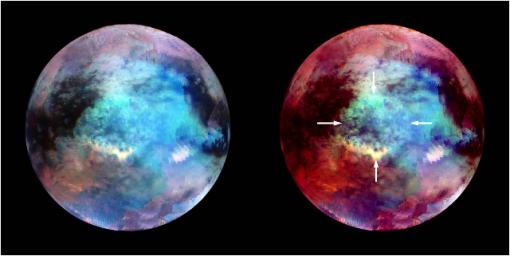
|
Circular Feature at Xanadu, Titan
- Click the image above for a larger view
- Full-Res JPEG (640 x 321) (28.4 kB)
- Full-Res TIFF (640 x 321) (617.2 kB)
Caption:
NASA's Cassini spacecraft obtained these false-color images of a circular feature in a region known as Xanadu on Saturn's moon Titan. The images, obtained by Cassini's visual and infrared mapping spectrometer, show Titan in infrared wavelengths of radiation.
The cause of this circular feature has been the subject of debate, but a group of Cassini scientists think a small asteroid or a comet could have caused an impact that excavated an enormous crater. There is very little topographical relief within the circular feature. Its center is slightly lower than the surrounding terrain, but there is otherwise noobvious evidence of the original crater's topography. A group of Cassini scientists argue that the circular feature seen in the infrared is basically a palimpsest, an object that has been altered but still bear traces of its earlier form. That is, these scientists argue, marks appear to show where the crater formed and where the ejected material was thrown, but the crater is so old that its walls and ejected material have eroded and viscously relaxed over time.
The image was obtained by the visual and infrared mapping spectrometer on April 30, 2006.
The image is centered at 10 degrees south latitude and 120 degrees west longitude. The VIMS team assigned the 1.6 micron wavelength of radiation a blue color, 2.0 microns a green color and around 5 microns a red color. The image on the right was heavily processed to bring out detail on the circular feature, with its outer edge indicated by whitearrows.
Background Info:
The Cassini-Huygens mission is a cooperative project of NASA, the European Space Agency and the Italian Space Agency (ASI). NASA's Jet Propulsion Laboratory in Pasadena, Calif., manages the mission for NASA's Science Mission Directorate at the agency's headquarters in Washington. The Cassini orbiter was designed, developed and assembled at JPL. The visual and infrared mapping spectrometer was built by JPL, with a major contribution by ASI. The visual and infrared mapping spectrometer science team is based at the University of Arizona, Tucson. JPL is a division of the California Institute of Technology in Pasadena.
For more information about the Cassini-Huygens mission, visit http://www.nasa.gov/cassini and http://saturn.jpl.nasa.gov/home/index.cfm .
Cataloging Keywords:
| Name | Value | Additional Values |
|---|---|---|
| Target | Titan | |
| System | Saturn | |
| Target Type | Satellite | |
| Mission | Cassini-Huygens | |
| Instrument Host | Cassini Orbiter | |
| Host Type | Orbiter | |
| Instrument | Visual and Infrared Mapping Spectrometer (VIMS) | |
| Detector | ||
| Extra Keywords | Asteroid, Color, Comet, Crater, Impact, Infrared, Visual | |
| Acquisition Date | ||
| Release Date | 2011-07-14 | |
| Date in Caption | 2006-04-30 | |
| Image Credit | NASA/JPL-Caltech/University of Arizona | |
| Source | photojournal.jpl.nasa.gov/catalog/PIA14311 | |
| Identifier | PIA14311 | |
